Take Two: The Beautiful Nightmare That Is David Lynch’s ERASERHEAD
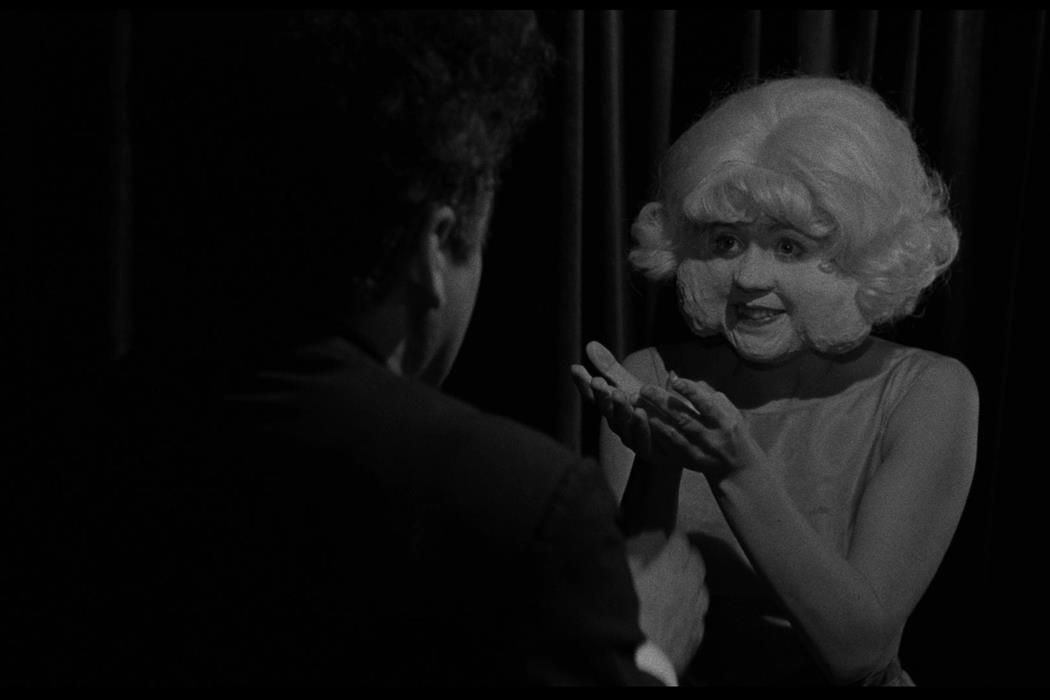
Michael Pementel is a Columbia College Chicago graduate of the…
I was twenty-one when I saw my first David Lynch film. Until that point in time, I only viewed film as an artform for entertainment. I enrolled in my first film class, and it was there that the concept of analyzing a work of art was introduced. Of that entire semester, Mulholland Drive is the film that stood out to me the most.
After that first viewing I became obsessed with Lynch and his work. As an artist, he has become one of my greatest inspirations. It is funny that of all his work, I had saved his most iconic piece for last.
Upon my first time seeing Eraserhead… I just didn’t get it. There were aspects that caught my eye, but I found myself far too lost. I couldn’t grasp the ideas or the characters, and felt as if I was just floating through the picture as a passive spectator (rather than engaged in the film).
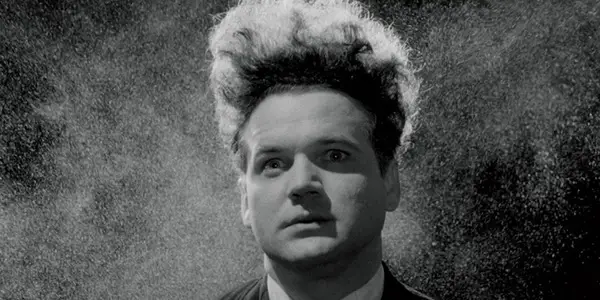
For those who aren’t aware, Eraserhead is David Lynch’s debut full-length film. It tells the story of Henry, who finds out his girlfriend has become pregnant. From there the film covers all the bizarre moments between Henry and the baby. What Eraserhead is most known for is its dark surrealist nature.
The picture is full of dark imagery, some of the scenes being outright eerie or disturbing. It is with all this imagery, however, that the film can actually be somewhat difficult to digest. Eraserhead is experimental in the ways it tells its story, and these manners can somewhat isolate the casual moviegoer.
It was with the release of season 3 of Twin Peaks that I decided to return to Eraserhead, a year later from the last time I had viewed it. With a stronger analytical eye, I found these new viewings much more intriguing (I had re-watched the film twice). I found the themes, I dug deeper into the characters, and I was able to get inside the head of Lynch.
“The Fear, Insanity, Corruption, Filth … Was So Beautiful To Me”
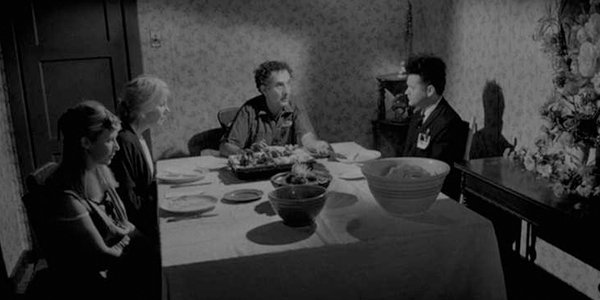
The picture opens up on a spacey backdrop, our main character Henry lying down sideways. The opening draws on for some time, as images of a rock-like planet fade in and out of Henry’s head. We then see a decrepit man covered in sores, pulling levers, eventually revealing a sperm-like creature unraveling itself from Henry’s mouth.
I didn’t bother to look anything up about Eraserhead prior to my first viewing, so within the film’s first ten minutes I was completely lost. After the abstract scene, we find Henry walking home. The area around him is filthy, nothing but a land of steel factory buildings and dirt. Henry’s home is that of a rundown apartment building, piles of dirt in corners of his room.
What helped give Eraserhead some context for me was watching Lynch’s new documentary, David Lynch: The Art Life. In that picture, Lynch talks about his life while living in Philadelphia. He describes the city as atrocious, filled with crime and disturbing people. Lynch describes living in fear of violence, and witnessing his neighbors behaving in lewd acts (such as one man grabbing a woman’s breasts, speaking to her in a baby voice).
This background gave a new sense to the characters and scenery of Eraserhead. The film’s characters are some of the oddest I’ve ever come across. There are drawn out scenes of people sitting around, going about their chores, the dialogue sparse or just non-existent. The film has a small cast, and other than Henry, no one is ever really fleshed out.
In the beginning, Henry is over at his girlfriend’s house, and while he is sitting on the couch, her father bursts in and begins talking about pipes and his knee. The scene comes out of left field, and it really doesn’t give any context to the characters, making for a large oddity. But upon viewing the film more, Eraserhead is sincerely just that – an oddity.
Like all of Lynch’s work, the film is never going to come outright and tell you what it is trying to say; that’s something I really love about Lynch, that while he has his own ideas, he gives the audience room to make up their own. I came to realize Eraserhead’s characters say more if you sit back and don’t overly stress trying to find something. With this context of Lynch’s feelings towards Philadelphia, I found every character as a reflection of his surroundings at that time. Most of the characters (while some do provide context to the themes) never develop, but add to the atmosphere of the picture.
At first, it was difficult to connect with Henry. Typically, I try to find a means to relate to the main character in a film, looking for the traits I can watch develop. Henry is a passive person, though, his progression taking place more on a mental plane than in reality. Unlike a lot of Lynch’s other work, there isn’t much here for physical action.
As far as story, the picture isn’t all that rich in each sequence of scenes. The story is essential of course to understanding the work, but it’s tough to say you’ll be on the edge of your seat waiting for “what happens next.” Eraserhead is Lynch’s first step into the world of dreams, and that’s where the film reveals its message. Along with those dreams is the overall aura of the setting.
Along with the odd characters, the consistent undertone of sound that flows throughout Eraserhead creates an ever-lingering presence of unease. With the industrial backdrop, there is always a hiss or a hum pulsating in each scene. Sometimes this is gentle, and sometimes it bursts through, the sound intensifying to a sinister level. Adding to the fact that the film is shot in all black and white, every element creates a bleak world.
When I took the chance to watch Eraserhead again, purely watching it without trying to over analyze, the images made themselves more apparent to me. The little details in the sound and dirtiness were more provoking, and I found my skin tensing with each hiss. I also found myself connecting with the characters, for the themes of Eraserhead shot out at me as I sat back, mindful and in the moment with the film. Lynch is someone who stands by mindfulness, and that’s how one needs to treat his work.
It was with this in mind, that I finally discovered what makes Eraserhead such an unnerving and provocative film.
A Dream Of Dark And Troubling Things
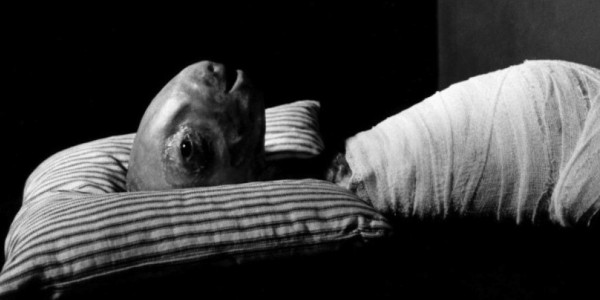
Eraserhead is a story of sexuality and the fear of parenthood. There are four characters that unlocked this for me: Henry, Mary, the Lady in the Radiator, and the Beautiful Girl Across the Hall. In each way, the characters represent at least one of these ideas (if not both).
Henry is timid, yet entranced of the idea of sex. Early on, Mary’s mother confronts him about having sex with Mary. Henry feels far too uncomfortable to discuss this with her, and to press him, she attempts to make a sexual advance.
This scene plays in contrast to Henry’s relationship with Mary. There are attempts to get close to her, but she grows all the more distant as they spend time with the baby. The child is mutated, and insistently cries throughout the night. This causes a rift between Henry and Mary, the two becoming aggressive towards one another.
In my original viewing, while I could see this rift taking place, I was looking for more substance through the character’s dialogue. But with the exception of moments where Mary shouts at Henry, there isn’t much to go off of. What makes these frustrations stand out are the actions taken by each character. It’s Henry escaping into daydreams, it’s Mary clenching her teeth in her sleep, or tossing and turning in bed that give the signs of their relationship’s decay.
Henry and Mary resent the child and how it has brought stress and limitations into their lives. The distance between the two grows as both begin to lose sleep, Mary eventually leaving Henry’s apartment. In this latter scene, Mary moves about the apartment crying and angry. She has just lashed out at Henry, saying how she can’t take being there and needs some sleep.
This causes Henry to be angry with her, saying how she should just go. She goes to reach under the bed for a suitcase, her face right behind the bars of the bed frame. Mary begins tugging at the suitcase and gripping the frame, crying with each tug.
That’s when it hit me – this is an interpretation of the two having angry sex. Now again, this is just my own interpretation, but in Lynch’s work, he has always displayed the act of showing something, without actually showing it. Like the transition of the main character being killed in Lost Highway, Lynch hides the actual event of something through clever deception. The scene further helped my understanding of Henry’s resentment towards the child, along with his sexual awkwardness and desire.
It is a few scenes afterwards that we get the intimate moment between Henry and the Beautiful Girl Across the Hall. She makes a brief appearance at the beginning, but it is towards the film’s end where her sex scene with Henry gives us an understanding of her role in the picture’s themes. Locked out of her apartment, she asks Henry if she can stay the night with him. The child begins to cry as Henry covers its mouth, and he takes the woman to bed.
As the two make love, the woman looks over to the child as it continues to cry. Her eyes are full of fear as Henry continues to make love to her. Later on, Henry finds her with another man. When she goes to look at him, she sees Henry’s body with the head of the child.
The Beautiful Girl Across the Hall also represents the fear of parenthood, and it locking away her freedoms. Henry’s attempt to be with her is an act of trying to be free, only to realize he is still trapped with the child.
This fear and resentment is further explored in Henry’s dreams, thanks to the Lady in the Radiator. The scenes where she appears are always accompanied by music (a trait for Lynch’s dream sequences since Eraserhead). One particular moment shows the girl dancing as sperm-like creatures flop onto the stage. As the girl dances, she purposely stomps on each one, killing them in the process.
Not only is the lady acting as a means of “killing” Henry’s fears, but she is his daydream desire. She is his escapism from a world he feels trapped in, a source of comfort among the lingering decay of the land and cries from the child.
At the film’s conclusion, Henry kills the child and himself. This is the only option left for him to find freedom. The act symbolizes his liberation from commitment, and means to escape into his desires (or just pure nothingness).
Again, none of this is ever verbally communicated between the characters, but acts out in a telepathic manner. It is a “read between the lines” picture, each subtle manner communicating part of the larger ideas. This is where Lynch began to hand his audience the responsibility in decrypting his work, a philosophy that would come with his future material.
In Heaven, Everything Is Fine
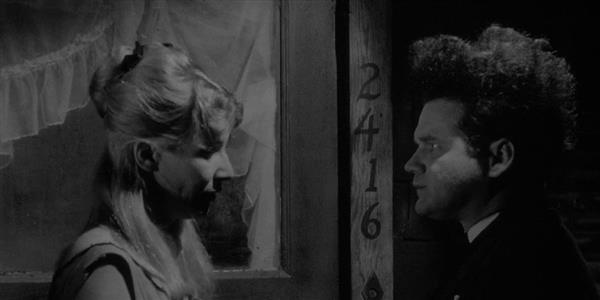
Perhaps it is because I’ve given the film a few more views, but Eraserhead has grown on me. I can proudly say it is another David Lynch film I can appreciate, and I can watch it now as an active audience member. What made this possible was learning to watch Eraserhead as it played out, without focusing on trying to find something.
You can’t follow Eraserhead like you would any other film because it’s more like a dream than a film. Lynch has stated that Eraserhead is his most spiritual work, and I must say I get that vibe. There’s still much to the work that I don’t understand. I can’t explain what the dirt and plants in Henry’s apartment mean, I can’t tell you my interpretation of the decrepit man.
The film is truly bizarre, and even to someone who has seen a Lynch film, it is still pretty out there. But it is a work that requests one’s patience as it unravels. For if you give it time, it will promise to share its dark treats with you.
What I can say is that I can finally feel Eraserhead. It is a nightmare that I’m able to get lost in, and as I wander, I discover more pieces. Those pieces may be abstract, but I have a grounds to base them off of.
Eraserhead pulls from Lynch’s early life, a place he came to hate and love. It is the beginning of an artist’s career in discovering themselves, and making sense of the world.
What are your thoughts on the storytelling of Eraserhead? And what makes the film special to you?
Does content like this matter to you?
Become a Member and support film journalism. Unlock access to all of Film Inquiry`s great articles. Join a community of like-minded readers who are passionate about cinema - get access to our private members Network, give back to independent filmmakers, and more.
Michael Pementel is a Columbia College Chicago graduate of the Creative Writing Program. With an immense love for pop and geek culture, he covers everything from film, video games, anime, and music. From editorials analyzing a given work, to digging into how our entertainment impacts us, he uses his writing to connect people with art. When he isn't writing, you can find him at the local movie theater with his fiancé, playing video games, or playing some sort of collectible trading card game. You can find more of his work here, as well as: FilmDaddy and New Noise Magazine.













